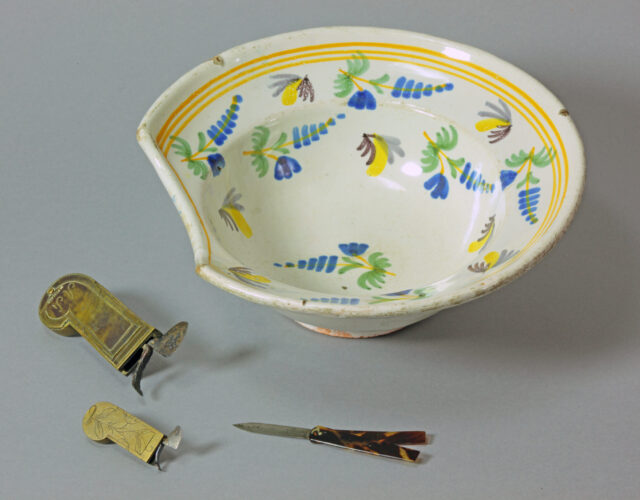In April 1841 Joseph E. Snodgrass, an American physician, editor, and occasional correspondent with Edgar Allan Poe, contributed a poem to a Baltimore newspaper. “To My Spring-Lancet” praises a tool then carried by all doctors. “I love thee, bloodstain’d, faithful friend! / As warrior loves his sword or shield,” Snodgrass declares before elaborating on how his small, double-edged, triangular blade had slain many foes and protected even more friends. Snodgrass’s poetry memorably reflected the public faith in bloodletting as medical treatment.
Before the modern era one tradition of medical thinking attributed disease to impurities or excesses in bodily fluids. This approach was inherited from ancient Greek medical practice. An imbalance among the four humors—black bile, yellow (or red) bile, blood, and phlegm—would lead to disease. Too much phlegm, for example, caused a person to be slow and dull, while too much black bile caused despair or insanity. Releasing the excess from the correct location could help restore the patient to health; where to make an incision and what volume of blood to take were questions of vital importance.
Though many kinds of blades were used for bloodletting, the lancet was the basic tool. Its small, narrow blade was designed to nick the vein, not sever it, nor to allow too much blood to flow too quickly. By the early 18th century doctors were using the spring-lancet, or Schnapper; the spring-action blade saved its user’s fingers from being cut and allowed for a quicker incision, though it was harder to control. The Schnapper became popular in the United States, and numerous examples remain, including two held by the Institute.
The ornamentation on lancets—many of which have tortoiseshell covers, brass embellishments, and inlaid carrying cases—may seem odd, but such decoration was due to the growing popularity of bloodletting. From the mid-17th century some doctors bled their patients to prevent illness rather than simply to treat it. This trend reached its zenith in the early 19th century, and the beauty of a doctor’s tools as well as his grace in holding a patient’s arm became increasingly important. Marshall Hall, a British doctor writing in 1836, did not endorse this sort of prophylactic bleeding, adding that no kind of bloodletting was “more replete with danger.” Hall still valued bloodletting in certain cases but did not consider it a cure-all.
Fever outbreaks in the 18th century and epidemics of cholera in the 19th century showed the limits of bloodletting: Snodgrass’s poem was published in the last years of the practice’s popularity. By the 1880s it had fallen into disfavor, as the knowledge of what caused disease was becoming ever more refined. Today, medicinal bloodletting may seem incomprehensible and even repulsive, though we retain the practice in the taking of blood for analysis. And in some rare cases, such as polycythemia (too many red blood cells) and hemochromatosis (too much iron in the body), treatment still requires bleeding a patient. These days doctors use a needle and a collection tube, however, rather than a lancet and a blood bowl.




